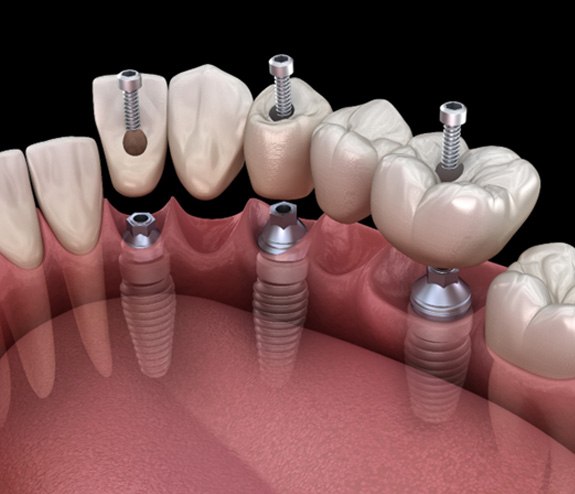Dental Bridges – Longmont, CO
Close the Dreaded Gap in Your Smile
Missing teeth are a common dental concern for millions of Americans, so if you’re missing one or several teeth in a row, know that you’re not alone and dental bridges can help. Our team partners with high-quality dental laboratories to craft replacement teeth that look lifelike, and if you’re looking for a more realistic feel and function as well, we can pair your bridge with dental implants. For questions or to schedule a consultation and learn more, call our office today.

Why Choose Longmont Complete Dentistry for Dental Bridges?
- Team of 3 Highly Experienced Dentists
- Family-Owned & Operated Dental Practice
- We Accept & Maximize Dental Insurance
What Are Dental Bridges?

Dental bridges are typically mentioned alongside dental crowns because they work together in unison – the new bridge is designed to resemble the missing teeth in their look and feel, and the crowns fit over nearby healthy teeth to hold it in place for permanent, lifelike results. During your consultation, our dentists in Longmont can help you determine if a dental bridge or a different tooth replacement option is the right fit for you.
Types of Bridges

Depending on your smile goals and your tooth loss situation, your dentist may recommend either a traditional or implant dental bridge.
Traditional Dental Bridge

Traditional dental bridges offer faster results, but they require alteration of your surrounding healthy teeth in order to support the restoration. As mentioned above, traditional bridges depend on your healthy teeth to act as abutments to hold the bridge in place. This offers natural-looking results and is cost-effective, but some patients prefer a more natural-feeling outcome. In these cases, an implant bridge may be the better option.
Implant Bridge

Following the loss of a single tooth or several teeth in a row, we can also recommend a dental implant-supported tooth replacement solution. For one lost tooth, a dental implant post can be used to support a custom crown. Unlike a fixed bridge restoration, the implant-retained crown is fully self-supporting, protecting your surrounding healthy teeth. If you’ve lost two or more teeth in a row, a dental implant-supported bridge can be placed. Rather than attaching to surrounding teeth for support, an implant-retained bridge is anchored to two dental implant posts.
The Benefits of Getting a Dental Bridge

When you invest in a dental bridge to repair your smile, you’ll be able to enjoy these amazing benefits:
- Improved oral health and reduced risk of further tooth loss.
- Maintenance of your dental alignment, as bridges prevent surrounding teeth from shifting.
- Results that look natural and will help you smile with more confidence.
- Easy maintenance—simply brush and floss your teeth like you normally would.
- Results that can last for 15 or more years with good dental hygiene.
Dental Bridges FAQs
How Many Teeth Can a Dental Bridge Replace?
Dental bridges in Longmont have been used for decades to treat consecutive tooth loss. They can replace one or more missing teeth in a row; however, longer restorations can be less stable. Often, traditional fixed bridges are recommended to treat one to three lost teeth. If you are missing more than that, a partial denture or an implant bridge may be the better option. Your dentist will help you make the best decision to enjoy longlasting results.
How Long Does a Dental Bridge Last?
A bridge and crowns can last for 5 to 15 years before needing to be replaced, but many factors will affect your restoration’s lifespan. Low-quality materials don't last as long as high-quality options. It's best to focus on quality over price when choosing materials for your replacement teeth. Back teeth undergo more pressure than those in the front. Bridges used for molars may have a slightly shorter life expectancy than those used for front teeth. You can get the most from your investment by brushing, flossing, and visiting your dentist regularly for a cleaning and checkup. Limit your consumption of hard or chewy foods. Moderate how often you have sugary foods and drinks. It's best to break any bad habits that may damage your bridge, like crunching ice or chewing on pencils.
Can You Take a Dental Bridge Out?
A dental bridge is meant to provide a long-term solution for lost teeth, so you cannot take it out. Dental crowns are bonded over your adjacent teeth to hold the restoration in place. If you prefer a removable option, ask your dentist about the benefits of a partial denture.
Are Dental Implants Cheaper Than a Dental Bridge?
Dental implants may cost more than a traditional bridge initially, but they are more affordable overall. Dental implants can last for 30 years or more with the correct care, so you'll never have to budget for replacements. Not to mention, they don't rely on healthy teeth for support to preserve your natural smile. With dental implants being the only solution to stop bone loss caused by missing teeth, you'll also enjoy reduced overall oral health expenses by stopping dental drift. You have multiple options to keep dental implants affordable, like monthly payment plans through a third-party financing company.
Does Getting a Dental Bridge Hurt?
Your dentist in Longmont will keep your comfort as their top priority. Numbing medications can be used to prevent discomfort. At most, you may feel some vibrations or pressure. It's not uncommon for your mouth to be tender for a few days after getting your bridge and crowns. You can manage it with an over-the-counter pain reliever and eating soft foods until your discomfort improves.
